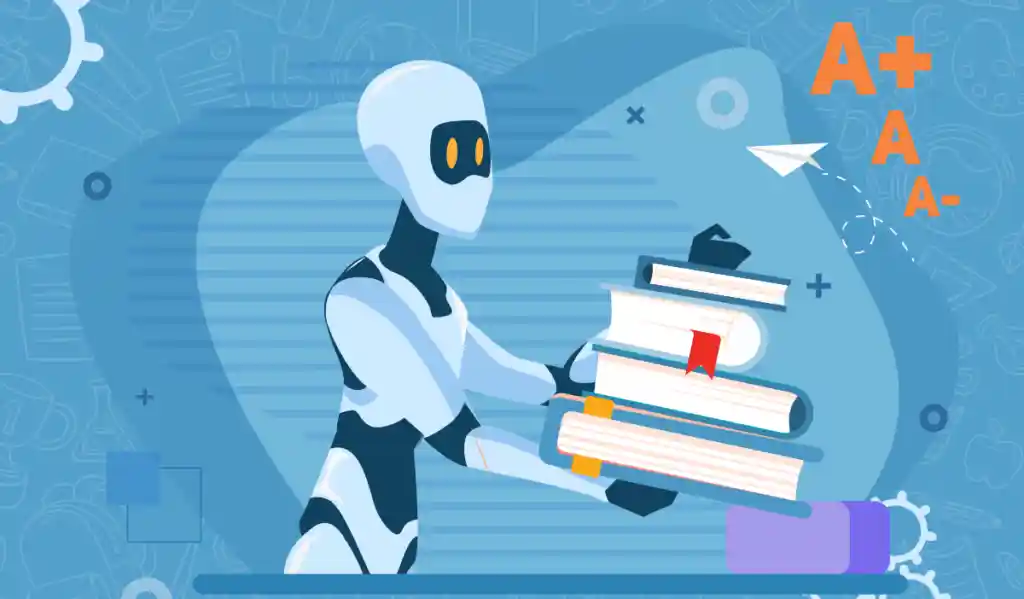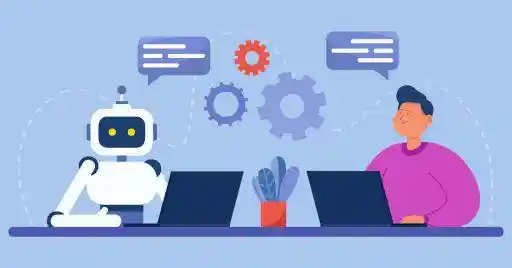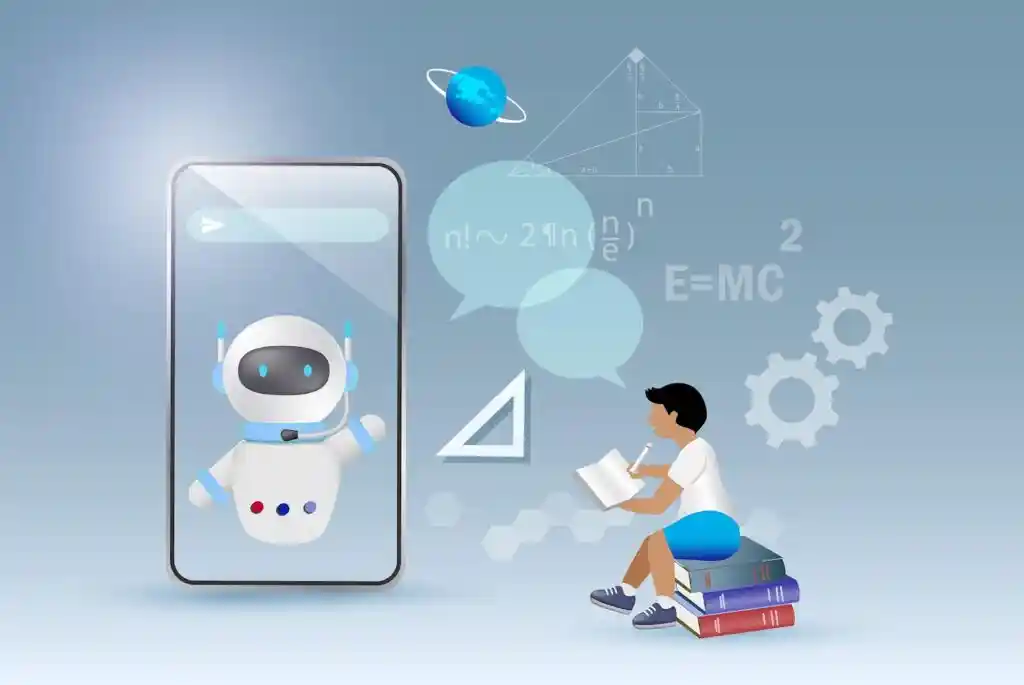AI Chatbots in Education: Enhancing Learning and Teaching
Table of Content
Discover how AI chatbots and learning bots are revolutionizing education. Explore the benefits and applications of AI in education, from personalized learning to efficient administration.
Introduction
The integration of artificial intelligence (AI) and machine learning is reshaping education. Traditional methods are making way for personalized learning, thanks to AI chatbots or learning bots. In this post, we’ll examine the advantages and uses of AI in education, focusing on the impact of AI bots.
Understanding Educational Bots
An educational bot, powered by Artificial Intelligence (AI) and machine learning, is a software tool designed to simulate human-like conversations. Using Natural Language Processing (NLP), these AI chatbots answer questions, provide personalized feedback, and support various educational activities. The key feature is personalization, as the bot’s responses adapt to the user’s input, closely resembling a real-life tutor.
These bots operate 24/7, offering students, teachers, and parents access to information and assistance at any time. From homework assistance and assignment explanations to doubt resolution, an educational bot can fulfill a range of educational needs.
The Influence of AI on Educational Institutions
The advent of AI and ML technologies has revolutionized the educational landscape, making AI an invaluable partner in fostering personalized learning environments.
Key influences of AI in education include:
- Individualized Learning Paths: By analyzing each student’s learning speed, strengths, and challenges, AI facilitates the creation of customized learning journeys. This personalization leads to improved learning outcomes and enables students to study at their own pace.
- Streamlined Administrative Tasks: AI chatbots automate various administrative functions, including enrollment processes, student data management, scheduling, and gathering feedback. This automation allows educational institutions to concentrate more on core teaching and learning activities.
- Customized Teaching Approaches: AI assists educators in closely tracking students’ progress, offering tailored feedback and assignments, pinpointing and addressing learning gaps. With a reduced administrative load, teachers can focus more on these instructional aspects.
- Enhanced Learning Engagement: AI contributes to more dynamic and interactive learning experiences. Through game-based learning, AI-driven resources, and instant support, students become more involved and enthusiastic about their education.

Advantages of AI Chatbots and Learning Bots in Education
With an introductory insight into AI chatbots and their transformative role in educational settings, we further investigate their advantages:
1. Personalization Through AI Chatbots in Education
AI chatbots are personalizing education! They analyze student data to create unique learning paths. This includes:
- Tailored Difficulty: Adjusting question difficulty based on student performance.
- Targeted Feedback: Providing personalized feedback to address individual strengths and weaknesses.
- Learning Style Matching: Suggesting study materials that align with a student’s preferred learning method.
- Structured Progression: Ensuring students master concepts before moving on.

2. Enhancing Learning Outcomes with AI Chatbots: The Role of ChatGPT in Education
- Personalized Tutoring: ChatGPT assesses student strengths and weaknesses, recommending corrective measures and personalized feedback.
- Engaging Interactions: Its ability to mimic human-like conversations makes learning sessions interactive and captivating.
- Tailored Feedback: Feedback is specific to each student’s learning journey, enhancing relevance and impact.
Continuous Improvement: As it interacts, ChatGPT’s AI constantly refines, becoming a smarter, more efficient learning tool.
3.Boosting Participation: The Power of AI Chatbots in Active Learning
AI chatbots, known for their interactive capabilities and personalized approach, play a crucial role in boosting student engagement. Traditional teaching methods often struggle to keep students focused and interested throughout the learning process.
In contrast, AI chatbots can captivate students’ attention by hosting interactive quizzes, initiating thought-provoking discussions, and maintaining a friendly demeanor. These features encourage students to stay engaged and actively participate in their education.
Furthermore, the immediate doubt resolution and individualized attention provided by AI chatbots create an engaging and adaptable learning environment. Their capacity to mimic human-like conversations further amplifies student interaction and engagement, making the learning experience more dynamic and enjoyable.

4. Personalized Virtual Tutoring with AI Chatbots
In this use case, we explore how AI chatbots are revolutionizing the tutoring process, making it more personalized, and engaging.

Flexible Tutoring: Students can connect with their AI tutor for quick doubt resolution, assignment help, or a study session.
Adaptive Learning: AI chatbots track students’ learning pace, strengths, weaknesses, and preferences, adjusting their tutoring methods accordingly. This leads to personalized content, feedback, and exercises, promoting an adaptive learning environment.
Overall, AI chatbots are transforming the educational tutoring landscape, making it more focused, personalized, and adaptable.
5. Administrative AI Chatbots for Admission Assistance
The admission process, typically characterized by chaos, can be significantly streamlined with the integration of AI chatbots:
- Resource Optimization: By automating administrative tasks, the admission process becomes more efficient.
- Handling Admission-Related Tasks: AI chatbots can manage admission-related tasks, including answering admission queries, assisting with form fill-up, and etc.
- Increasing Efficiency: With the AI chatbot’s round-the-clock availability, the overall efficiency and effectiveness of the admission process are remarkably increased.
- Immediate Responses: Prospective students and parents can receive immediate responses to their queries.

Key Features of AI Chatbots and Learning Bots in Education
Exploring the depths of AI and ML in the educational sector unveils the core features of AI learning bots.
This section highlights:
- Natural Language Processing (NLP) Abilities
- Interactive User Platforms
- Support Channels for Bot Users
1. Natural Language Power
AI chatbots leverage NLP (Natural Language Processing) to understand user input and respond naturally. This includes:
- Sentiment Analysis: Recognizing emotions in user messages for better response tailoring.
- Error Tolerance: Understanding user intent despite typos or grammatical mistakes.
- Context Awareness: Grasping conversation flow for relevant and continuous interactions.

2. Interactive Platforms for AI Chatbots in Education
Educational AI chatbots need user-friendly interfaces accessible to all. Here are some common platforms:
- Mobile Apps: Many schools offer dedicated apps with built-in chatbots for personalized learning support.
- Website Bots: These answer website visitor questions directly on the school’s website.
- Messaging Apps: Chatbots can be integrated with platforms like WhatsApp for convenient support.

3. Support Channels Available for AI Chatbot and Learning Bot Users in Education
Providing support channels for AI chatbot and learning bot users is crucial to ensure a seamless interaction experience. Even with advanced capabilities, there may be instances where users encounter challenges while engaging with the bot.
Having accessible support channels to address these issues is vital:
- User Manuals and Guides: Comprehensive user manuals and guides can offer step-by-step instructions on navigating
- In-Chat Support: The AI chatbot itself can be programmed to offer assistance if users encounter any difficulties during the interaction.
- Phone Support: Some educational institutions might also provide phone support, allowing users to receive immediate assistance for urgent concerns.
- FAQs: A well-structured FAQ section can address common questions and challenges.
- Email Support: Users can reach out via email, detailing their issue, and the support team can provide the solutions.
Highlighting Successful Implementations of AI Chatbots in Education
After gaining a comprehensive understanding of AI chatbots and their transformative impact on the education sector, we now turn our attention to real-life implementations of these technologies in educational institutions worldwide:
- Experiential Dimension: We will explore how AI chatbots have been effectively utilized in various educational settings, adding a practical perspective to our discussion.
- Reinforcing Understanding: These real-world examples will reinforce our understanding of key concepts such as ‘how AI supports education,’ ‘the impact of AI on educational institutions,’ and the synergy between ‘AI and educational institutions.’
By examining successful implementations, we can appreciate the tangible benefits and potential of AI chatbots in enhancing the educational experience and driving innovation in the sector.
The UK Cabinet Office’s Utilization of AI in Education
The UK Cabinet Office has embarked on an innovative collaboration with GreenShoot Labs to launch the Ask Jasmine project, an AI chatbot designed to support young adult career development education:
- Transformative Impact: The Ask Jasmine project exemplifies the transformative impact of AI bots in the education sector, showcasing their potential to aid in career choices and enhance administrative tasks.
- Proactive Engagement: Ask Jasmine is not just a passive query-answering bot; it actively engages users by providing advice and resources, encouraging the exploration of interests and opportunities for career development.
- Commitment to Accessibility: This initiative highlights the Cabinet Office’s dedication to leveraging AI technology to create accessible and equal educational opportunities for young adults.

University of Rochester’s Use of AI
The University of Rochester in New York stands as a prime example of successful AI implementation in education:
- Leveraging AI Technologies: By utilizing AI’s Natural Language Processing and Machine Learning capabilities, the University of Rochester enhances library efficiency and demonstrates the effective integration of AI in educational administration.
- AI Bot ‘Carlson’: Developed in collaboration with IBM’s Watson, their AI chatbot ‘Carlson’ is named after the Science and Engineering Library. It has significantly transformed library services.
- Efficient Task Handling: Carlson efficiently manages tasks such as answering queries, locating books, and providing information, streamlining the library’s operations.

Bot Implementation in Podar Education Network
The Podar Education Network has effectively implemented the AI chatbot Engati to improve parent-teacher communication and streamline academic and administrative tasks:
- Streamlining Administrative Processes: Engati also simplifies administrative processes such as fee payment, admissions, and scheduling parent-teacher meetings, enhancing the overall efficiency of the educational institution.
- 24/7 Communication Channel: The bot serves as a round-the-clock communication channel, addressing queries related to homework, attendance, exams, and activities, ensuring parents are well-informed and engaged.
These real-life AI bot implementations illustrate the diverse and significant contributions of AI chatbots to the education sector, driving innovation and accessibility in learning and career development.
Also, ChatMason empowers educational institutions to become blogging powerhouses! Brainstorm blog ideas, generate content with research assistance, and personalize it for diverse audiences. ChatMason even helps with scheduling, promotion, and analyzing reader engagement, freeing up educators’ time to focus on what matters most – knowledge sharing.
The Future of AI Chatbots and Learning Bots in Education
The incorporation of AI chatbots and learning bots into educational frameworks is still in its early stages, presenting a vast and exciting horizon for future developments.
Looking ahead, the future of AI in education may encompass:
Wider Accessibility: As technology advances and becomes more cost-effective, the use of AI bots in education is likely to extend to a broader demographic, including students in remote and underserved regions.
Enhanced AI Tutors: AI tutors are expected to become more advanced, capable of covering a broader range of academic subjects and providing more comprehensive tutoring sessions.
In summary, the integration of AI chatbots and learning bots in education is paving the way for a transformative future. They are poised to become an essential component of the educational landscape, reshaping both the pedagogical and administrative aspects of educational institutions.
Conclusion
In summary, the key pillars of AI chatbots in education encompass natural language processing, interactive platforms, and accessible support channels. These technologies are revolutionizing the educational landscape by making learning more personalized, engaging, and accessible.
Through real-world cases such as virtual tutoring, teacher assistance, and streamlining admissions, AI chatbots are paving the way toward an educational utopia. In this utopia, every student receives personalized learning experiences, teachers can focus more on teaching, and educational institutions operate with heightened efficiency.
The time is ripe to harness the magic of AI chatbots to shape both our present and future in education, unlocking new possibilities and transforming the way we learn and teach.
FAQs
- Are AI chatbots replacing teachers?
- AI chatbots are not designed to replace teachers, but rather to act as a valuable supplement. They can handle routine tasks, personalize learning experiences, and provide 24/7 access to information and support, freeing up teachers for more complex instruction and student interaction.
- What are the benefits of AI chatbots for students?
- AI chatbots can offer students a personalized learning experience, tailoring difficulty levels, providing targeted feedback, and answering questions in a conversational way. They can also be engaging and interactive, making learning more fun and motivating.
- What are some concerns about using AI chatbots in education?
- Some concerns include potential bias in the AI’s responses, over-reliance on technology, and the impersonal nature of bot interactions. However, with careful selection and implementation, AI chatbots can be a valuable tool that complements, not replaces, human educators.
- How can teachers get started using AI chatbots in their classrooms?
- Many educational institutions are already piloting AI chatbot programs. Teachers can explore these options, research different platforms, and consider how chatbots can best support their specific curriculum and teaching style.



